How To Read A Carfax
Autohitch has spent some time in other articles discussing the Carfax Buyback Guarantee and How To Get a Free Carfax, but in this post, I wanted to address the basics of Reading a Carfax Report because when you pull one-
There are sections that are bright, shiny, and colorful that sellers want you to see, and there are others that do not stick out:
But those areas are just as important!
Table of Contents
What Does a Carfax Report Show
Here is an easy-to-understand table summarizing what is included in a Carfax vehicle history report:
| Type of Information | What It Shows |
|---|---|
| Title Information | Salvage/junk titles, title brand history, ownership transfers |
| Mileage History | Odometer readings over time from official sources |
| Accident Records | Police and insurance reports indicating collisions or damage |
| Open Safety Recalls | Any manufacturer recalls still needing repair |
| Service History | Repair and maintenance records from dealers/shops |
| Previous Owners | Number and locations of past owners |
| Auction History | If the vehicle was ever sold at auction |
| Vehicle Use | Rental/taxi/fleet use showing more wear vs personal use |
| Theft Records | If reported stolen with no recovery indicating issues |
| Import History | U.S. registration/use history for imported vehicles |
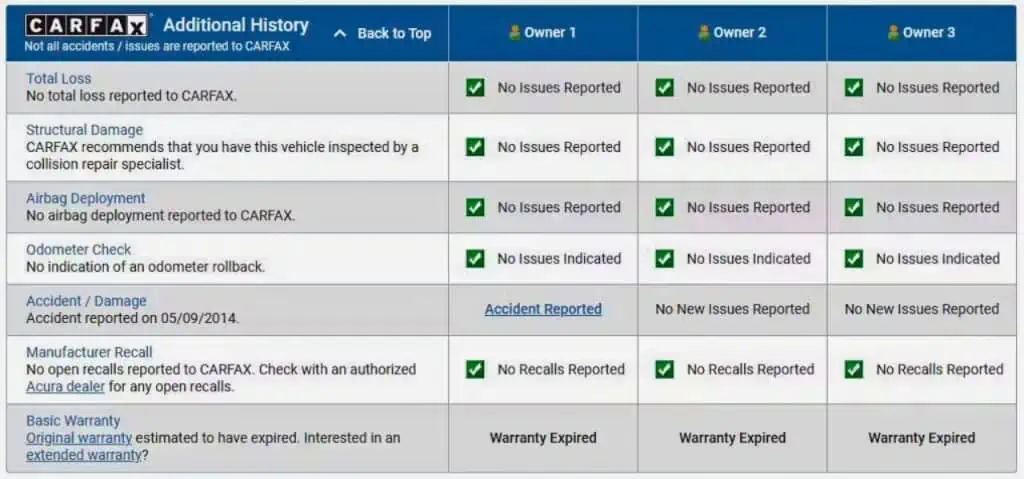
What a Carfax Report Doesn’t Tell You
A Carfax is designed to show you everything in the vehicle’s history…
That was reported!
But not every bit of damage or history is reported.
Who Reports To Carfax
| Source | Information Provided |
|---|---|
| State DMVs | Title information, odometer readings, branded titles |
| Police Departments | Accident reports, theft records |
| Insurance Companies | Claims for accidents, weather damage, theft |
| Collision Repair Facilities | Repair orders indicating prior accidents or damage |
| Service Shops & Dealerships | Maintenance and repair records |
| Auto Auctions | Damage announcements and inspection reports |
| Fleet Companies & Rental Agencies | Fleet maintenance and use history |
Related Article: Is Carfax Reliable
What a Carfax Doesnt Show
Some of the things you should not expect to find in a carfax are:
1. Current Mechanical and Cosmetic Condition
A Carfax report only provides historical information from its databases. It does not physically inspect vehicles or give any indication of the current state of the engine, transmission, electronics, upholstery etc.
A car can have a perfect report but still have undiscovered mechanical issues or cosmetic damage.
2. Unreported Accidents, Repairs and Damage
Not all collisions, repairs, and damage get officially reported and logged in Carfax’s systems. Anything that does not appear in their records will be missing from the report, like minor work done by independent shops instead of dealerships.
Theft and recovery frequently goes unreported as well.
3. Details on Accident and Damage Severity
While Carfax does include some detail on reported major accidents, aspects like dollar amounts of repairs and assessments of structural damage may not be included.
So the true severity and extent of previous incidents may be unclear.
4. Gaps in Ownership History
For imported used cars, Carfax only includes history trails from within the US and Canada. It does not incorporate full records from outside North America prior to import. Some sellers know how to illegally “wash” branded salvage titles to get clean titles, hiding prior major collision damage.
As you can see, plenty of very important information can be missing from these vehicle history reports, and this is why I will always tell you that a Carfax or an Autocheck report is only a guide and a starting point, not a deciding factor.
Related Articles to Read:
Red Flags On A Carfax Report
For the reader in a hurry, let’s skip by what you may consider “Obvious” Red Flags on a Carfax and get to a couple you may not have considered yet:
1. Listed As A Manufacturer Vehicle
The most unknown item to look for on a Carfax, but no less important, is a notation that a vehicle was, “Listed as a manufacturer vehicle, sold at auction”.
For a more in depth look into exactly what that is, read the article attached to the link.
But, essentially, these vehicles usually had such serious defects that the manufacturer had to buy them back from an owner. They are not always defective cars!
They could also have been a car used in displays at auto shows or used as a test vehicle.
So, if you see this on your vehicle’s history, make it a point to ask the dealer why the manufacturer sold the car at a dealer’s auction and if it’s related to defects or simply a show car.

Vehicle Sold At Auction (#9)
As Carfax will mention in their reports- “Millions of used vehicles are bought and sold at auction every year,” a seemingly obvious attempt to downplay dealer auctions as no different than any other vehicle purchase/sale, but that just simply isn’t the truth.
A car sold at the dealer auction is:
A car that another dealer couldn’t sell.
In fairness, that could be for a few reasons that are not “Negative”, such as:
- Maybe the dealership is clearing out room on the lot
- Maybe the dealership is franchised and has liability concerns limiting the sale of certain used cars
- Maybe there was a bank repossession and it’s the bank selling the car
On The Other Hand:
- Maybe the franchise dealership couldn’t sell the car because it had too many flaws/recalls/defects
- Maybe the dealership had the car sitting on their lot too long (Wouldn’t sell)
- Maybe the car is simply undesirable (Accidents, Damage, ETC)
The Bottom Line on Vehicles Sold at Auction
The car is at the auction because the current owner can’t/won’t sell it. If they could, and make a good profit, they likely wouldn’t be there (They are Dealers, Right?). That being said- That isn’t ever going to be enough for me to recommend that you don’t buy one of these vehicles (Far from it). But a vehicle sold at a dealer auction IS at the least a Yellow Flag to trigger an independent vehicle inspection.
2. Carfax Was Pulled Weeks Before!
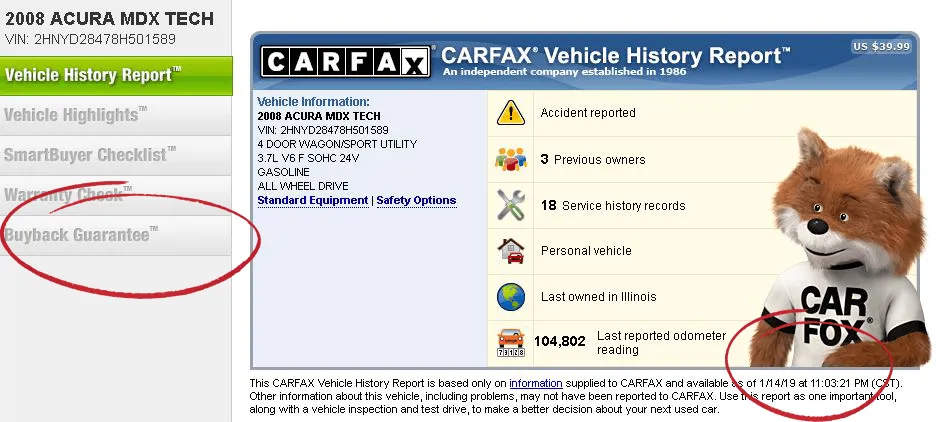
Check Your Report Date
Always be sure to check the date of any Carfax you are presented and request a new one if you receive one that is several weeks old! (Dates can be found under the main score card and inside of the “Buyback Guarantee” tab.
Why?
Dealers know that consumers are weary of vehicles purchased at dealer auctions and that you would much rather buy a used car that they obtained directly from its original owner.
So, some dealers decide to pull the carfax reports of vehicles BEFORE they are sold at auction.
This provides them with a vehicle history report that looks as if the previous owner must have just sold or traded in the car.
3. Carfax Accident Reported and Damage Reported
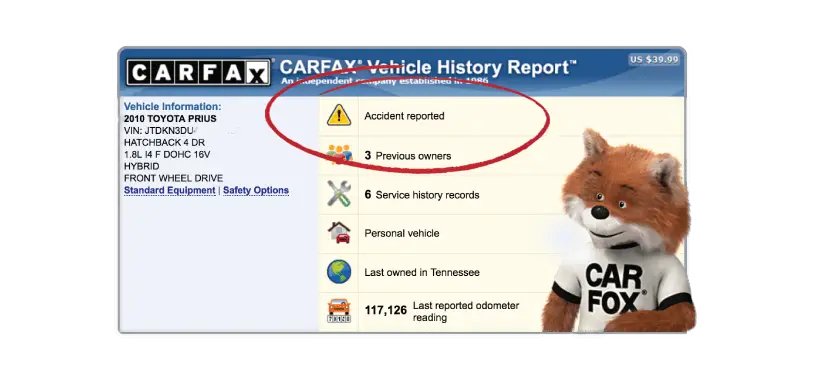
The first and undoubtedly most important section of the Carfax Report is the Carfax Accident and Damage Report.
Here, you will see either a big green check mark or a yellow/red warning sign.

The Yellow Warning Sign (Pictured Above) will indicate an accident or damage that was reported, and it is important to note that accident reported and damage reported can be two different things:
- Accident Reported– This specifically indicates that the vehicle was involved in an accident with another vehicle. Accidents are typically reported by police departments or insurance companies and often involve a police report being filed.
- Damage Reported– This could refer to any damage to the vehicle, whether from an accident with another car, a single-vehicle incident, or even minor dents or scratches. Damage can be reported by various sources, such as insurance companies, body shops, or even vehicle owners themselves.
TIP: The distinction is important because “damage reported” could be minor or cosmetic, while an “accident reported” suggests a more significant incident.
Minor Damage Report
If you see Minor Damage on a Carfax, it means the car had cosmetic damage that does not impact the vehicle’s structural integrity or ability to be driven safely. It’s the least severe damage category of a Carfax Report and shouldn’t always be perceived as a negative.
Types of Damage Associated with Minor Damage Reports:
- Scratches, scrapes, or dings to the body of the vehicle
- Small dents, such as a cracked headlight or minor dent in the hood
- Damage that did not require the vehicle to be towed from the scene of an incident
Functional Damage Reported
Seeing “functional damage reported” on a Carfax vehicle history report indicates the car sustained damage in some sort of incident but could still be driven afterward.
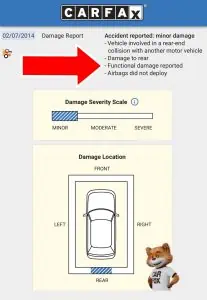
- This means the damage was repairable and not severe enough to require towing or render the car inoperable immediately. As long as thoroughly fixed, it may have no long-term impacts.
- It typically refers to exterior damage on one side of the car from a minor collision or sideswipe that didn’t compromise frame integrity.
- Airbags may or may not have deployed, which clues into damage severity. Police reports also aren’t always filed for functional damage incidents.
Essentially, “functional damage reported” means noticeable but not major damage occurred that allowed the vehicle to still get driven away under its own power.
Disabling Damage Reported
Seeing “disabling damage reported” indicates the vehicle was damaged significantly enough in an accident to prevent it from being driven away from the scene. (See Vehicle Towed Section Below).
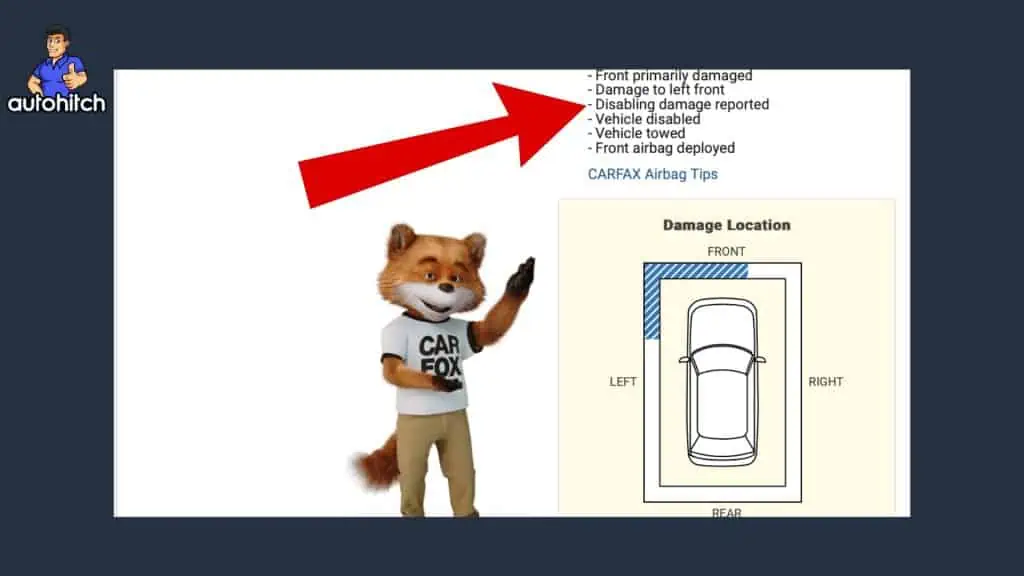
- Disabling damage means the car had to be towed after the collision due to extensive repairs needed. It could not be operated safely without fixes.
- This level of damage is more major than “functional damage”, where the car can still drive itself away afterwards.
- Disabling damage points to structural impairment, mechanical issues, or airbag deployment that rendered the car undriveable.
- It signals the accident impacted body integrity, frame damage, mechanical systems, or safety equipment enough to disable mobility.
- Extensive repairs are typically required after disabling damage to make the car roadworthy again.
Carax Showing Vehicle Towed
Expert Tip: If a Carfax report shows that a vehicle was damaged or in an accident, the most important factor as to whether this should affect your purchase is if the report shows “Vehicle Towed.”
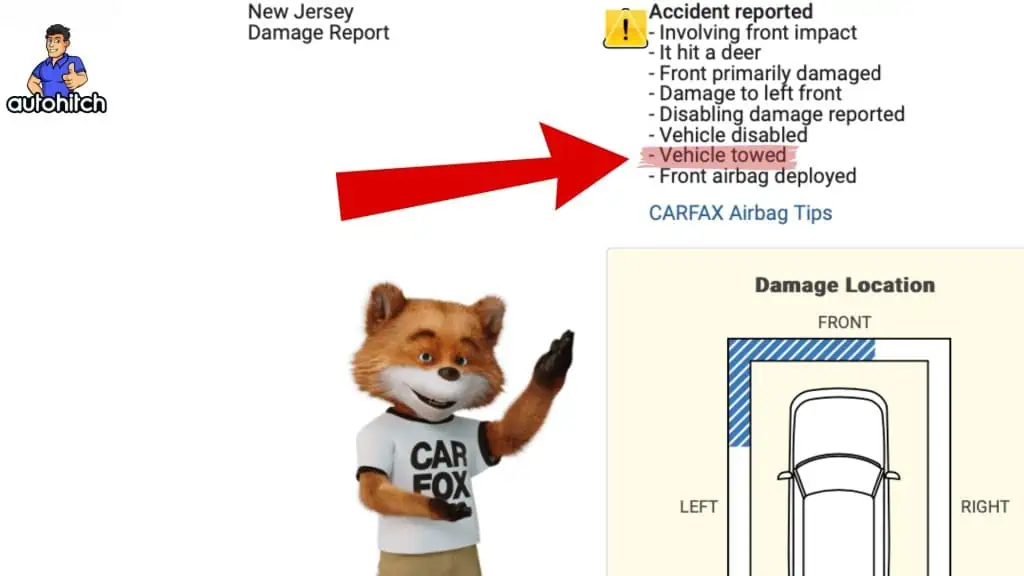
This is important because the damage went beyond just the cosmetic appearance. The car’s structure was so damaged so badly in the accident that it became unsafe to drive.
This doesn’t necessarily mean you cannot purchase the car!
In fact, if you can verify (preferably through a mechanic or vehicle inspector) that the repairs were done correctly, then it’s not a deal breaker.
However,
A vehicle that only shows “Minor Damage” or a vehicle that was able to be driven away only loses a minimal amount of value.
In contrast, a vehicle that had disabling damage and was towed away takes a major hit off of any potential sale price and must be a factor in your price negotiation.
4. Carfax Branded & Salvage Title (Title Status)
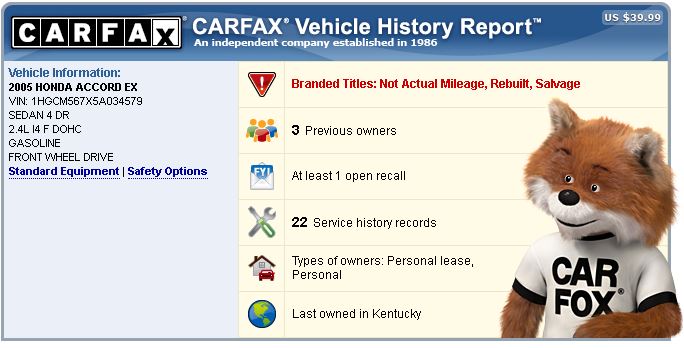
A Red warning sign inside the top box of your report will refer to a vehicle that has a Branded Title. From there you will also get a breakdown of a few factors that could include:
- Salvage
- Rebuilt
- Flood
- Not Actual Mileage
What is important to pay attention to in this section is if you only see the designation of “Salvage”, or if “Rebuilt” is also included.
The difference between a Rebuilt and Salvage title is going to be the difference in whether you buy a car that is street legal or not, so yes:
It’s Very Important!
If you would like more information (In detail) on the difference between a Branded, Salvage, and Rebuilt title vehicle, please head over to our post, “Salvage And Rebuilt Title Cars | Buyer Beware or Great Deal?”
5. Number Of Owners
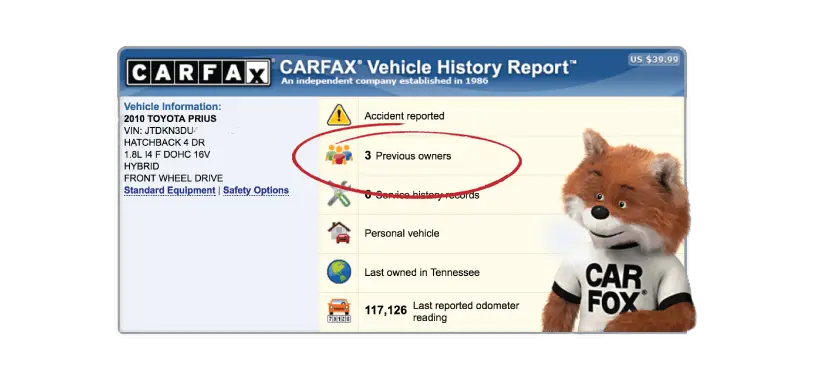
Too Many Owners “Is” A Negative
The next section of a Carfax Report that you should pay attention to is the number of owners. To make this simple: If you have a car that’s three years old, you should have no more than one owner.
If you have a car that’s ten years old, a good number would be three owners.
Please remember:
These estimates should only be used as guidelines and should never substitute for common sense.
If you are buying a car that’s three years old with two owners because the first owner gave back a car to the dealership the same week they bought it, that’s not going to be considered a negative.
You also have Lease Swaps that are becoming more and more popular, which can create more owners than we are typically accustomed to seeing.
6. Service History And Service Records
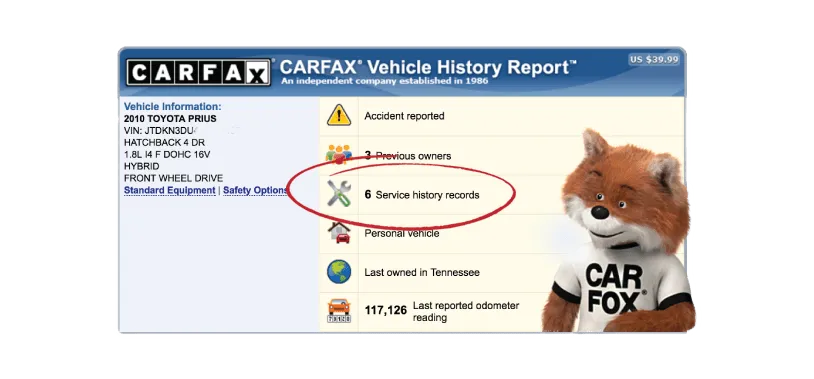
This section of the Carfax Report probably grinds my gears the most- Service History Records. Let’s clear the air about this part of the report:
Lack Of Service Records Is Not A Negative Factor When Buying A Used Car
The very nature of Vehicle History reports makes their value vulnerable to a lack of reporting, and there are simply too many mechanics and service departments that do not report vehicle services for you to self-determine that a car without a service history means the car wasn’t cared for.
I myself change my own oil, which actually allows me to use higher quality materials because that way they become more affordable.
Doesn’t That Make My Car Better?
It should, but sadly because this is not going to be on my Carfax Report, your typical used car buyer (You, for example) might actually get a bad feeling about my car, possibly concluding that I never changed my oil.
7. Type Of Ownership
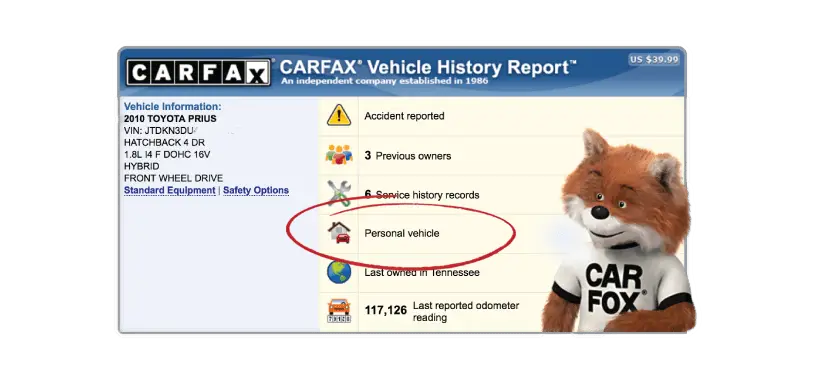
How A Used Car Was Driven Matters
I would venture to say that the section of the Carfax which identifies the type of ownership a car was registered under is the most skimmed over on the report, and like any section, it shouldn’t be, because it’s there for a reason.
To understand why the type of ownership matters, let’s look at an example: We don’t like cars with multiple owners because that’s more drivers, and that usually means the chance for a vehicle to be driven harder goes up.
Now apply that line of thinking to buying a rental car…
The types of ownership on a Carfax
- Personal
- Fleet
- Commercial
- Rental
- Govt or Municipal
Before you assume that I am going to tell you anything outside of personal ownership is bad, let me stop you! I actually really like Government or Municipal Vehicles and “Some” commercial vehicles.
Government Cars:
Cars used by government agencies tend to be (At the least) very well maintained and (In certain instances) have very low miles. Because of this, don’t overlook a vehicle just because a government agency used it.
Commercial Vehicles on Carfax:
Commercial Vehicles on Carfax are classified as simply vehicles that were registered to a business.
This means they could be used heavily for travel or deliveries, or they simply could have been a car the owner decided to put under their business’s name rather than their own.
For this reason, if you see a vehicle marked as Commercial, look a bit deeper and see if it might have been a car that was used more like a personal car (12k miles a year, clean, maintained)
Related Articles: What Does Corporate Vehicle Mean on a Carfax
8. Location Of Last Registration
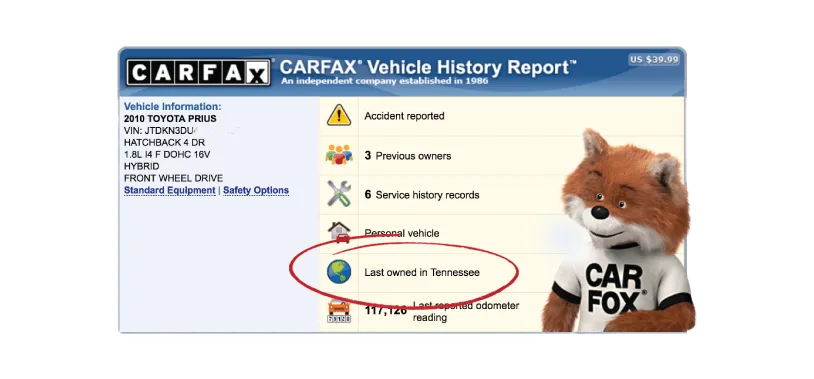
Avoid Rust Cars?
This section of the Carfax Report is going to tell you the last state the vehicle was registered in. The idea behind this information is that if you see a car from a northern state, or a state that is known for a lot of snow and salty roads, you can try to avoid that vehicle or at least be alerted to the fact that it may have potential rust problems.
Do New Cars Rust?
The simple answer is yes. The more complex answer is “Supposedly not as fast”. It’s said that newer cars are built to withstand the salt of northern roads better, but from everything I have seen and heard it’s not so much of a preventive defense as it is something that delays the inevitable.
Tip:
Continue to be weary of cars from up north more so than cars from the south (Florida, Texas, etc) because of potential rust issues. If you are able to get a vehicle inspection and find no rust, then the cars are comparable.
9. Last Reported Odometer Reading
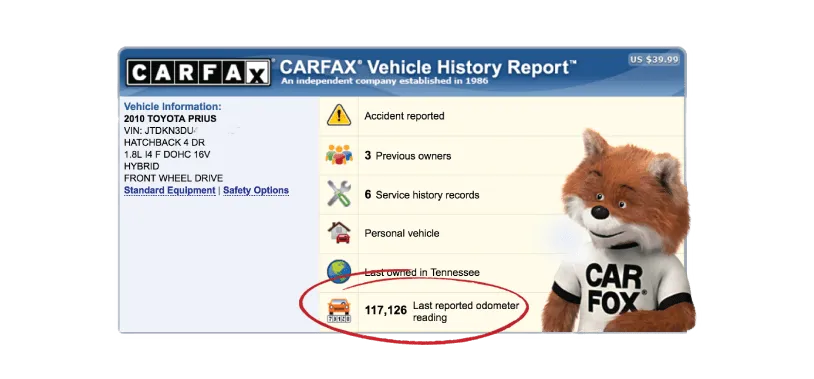
Has The Odometer Been Tampered With Or Rolled Back?
The bottom section in the Carfax Report Card is going to address the odometer and show you the “Last Reported Odometer Reading”. This particular section of the report is designed to protect used car buyers against anyone who may have rolled back a vehicle’s odometer so that they could sell a car for more money (Showing low miles).
Can An Odometer Be Rolled Back? (2019)
The answer is that in 2023 an odometer can still be rolled back. Listen: If you can hack Facebook, then someone can figure out how to rollback a car’s mileage! That being said, it is less of a problem than it used to be, but it can and does still happen; however, having the last reported mileage shown on a Carfax makes any attempt very difficult to pull off unless you are only shaving off a few thousand miles, and why would they waste their time doing that?
10. Total Loss On Carfax
“Total loss” on a CARFAX report indicates that an insurance company has declared the vehicle as a total loss. Key points to understand about vehicles marked a total loss include:
- Cost of Repairs Exceeds Value: This status is typically assigned when the cost to repair the vehicle is more than about 75% of its pre-damage value.
- Not Necessarily a Branded Title: A total loss declaration doesn’t automatically result in a “salvage” or “rebuilt” title.
- Significant History Indicator: The total loss status is an important aspect of a vehicle’s history, indicating major past damages.
- Buyer’s Caution Advised: Prospective buyers should conduct thorough inspections and verify repairs before purchasing a vehicle with a total loss history on CARFAX.
11. Unibody Damage
If you see “unibody damage” mentioned on a Carfax report, it indicates that the vehicle’s structural integrity may have been compromised.
The unibody is the primary structure of most modern cars, and damage to it can affect the vehicle’s safety and performance. If you come across this term, have a mechanic inspect the car thoroughly to assess the extent of the damage and the quality of any repairs made.
12. Lease Vehicle
The designation of a Lease Vehicle is somewhat up for debate as to whether its a good thing or a bad thing:
- Good: A leased vehicle is usually only 2-3 years old, has lower mileage, and had regular service at the dealership which means mechanically it was maintained.
- Bad: Someone who leases a car typically has no care or concern for the vehicles condition long term. This means they could have driven it harder and with less care, eventually leading to wear and tear having an effect on the car earlier in its lifespan.
Reading A Carfax Report- Conclusion
Remember- Carfax reports are not the deciding factor, they are a guide. They can tell you a whole lot if you know what to look for, but they can miss just as much. The fact that you should buy a pre-purchase car inspection isn’t negated by a “Clean Carfax”, and if you are trusting the purchase of any used car to a sheet of paper, in today’s world, you should expect some surprises down the road.
If you have any questions we have not covered here, please feel free to comment them below!
Reading A Carfax Report (FAQ)
Who Reports To Carfax?
CARFAX receives vehicle history data from over 139,000 different sources, which include:
- Every U.S. and Canadian provincial motor vehicle agency
- Police departments
- Fire departments
- Collision repair facilities
- Service shops
- Auto auctions
- Towing companies
- Fleet companies
- Banks and lenders
- Insurance companies
Overall, CARFAX leverages data from thousands of sources to produce its reports.
What Gets Reported To Carfax?
Here are some key items that get reported to CARFAX:
- State motor vehicle records – These provide title information, odometer readings, branded titles for issues like salvage or flood damage.
- Police reports – Police can report accidents, thefts, and other incidents involving vehicles.
- Insurance claims – Insurers report claims for accidents, weather events, vandalism, theft, and more. This reveals damage history.
- Collision repair facility invoices – Body shops submit repair orders that often indicate prior accidents.
- Auction announcements – Auctions document damage found during inspections and announce issues to buyers.
- Maintenance & repair records – Oil change facilities, dealerships, and independent shops submit this data which shows vehicle use and care.
Remember:
Reporting is voluntary, so gaps can and DO exist in the histories, especially for minor issues.
This is why Autohitch and even CARFAX suggests complementing their reports with an inspection. Not everything gets reported to or captured by CARFAX.
Damage Reported Vehicle functional
When you are looking at your Carfax Report and see, “Accident/Damage Reported Vehicle Functional”, this means that the car was indeed involved in an accident, but that it did not need to be towed away.
In this instance, the fact that a vehicle could be driven away signifies damage that wasn’t (Very) serious.
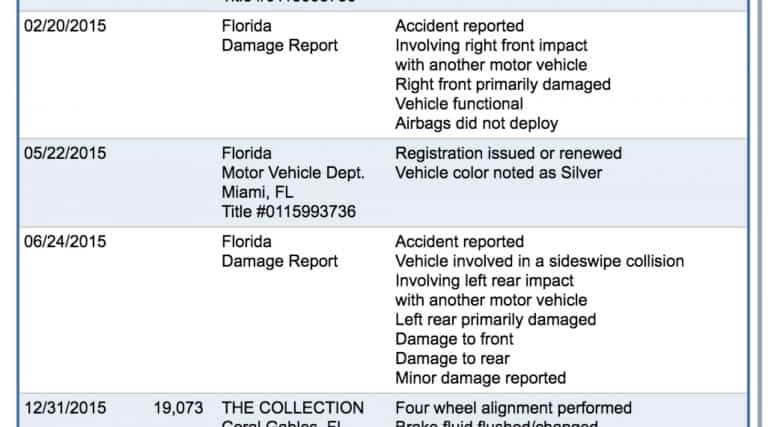
What Does Minor Damage Mean On A Carfax Report
Essentially, minor damage shown on a Carfax is typically going to refer to damage that doesn’t result in the vehicle having to be towed. It is somewhat similar in nature to when Carfax lists a car as having functional damage reported; however, minor damage is typically going to be much less significant types of damage such as:
- Scratches
- Dings
- Dents
Damage Reported On Carfax But No Accident
It is actually very common to pull a Carfax Vehicle History and see that damage was reported to a car, that at the very same time, was showing a history with no accidents. The perfect example of an event that could cause this would be when you back out of a parking space and hit something other than another car, maybe a tree or a pole.



